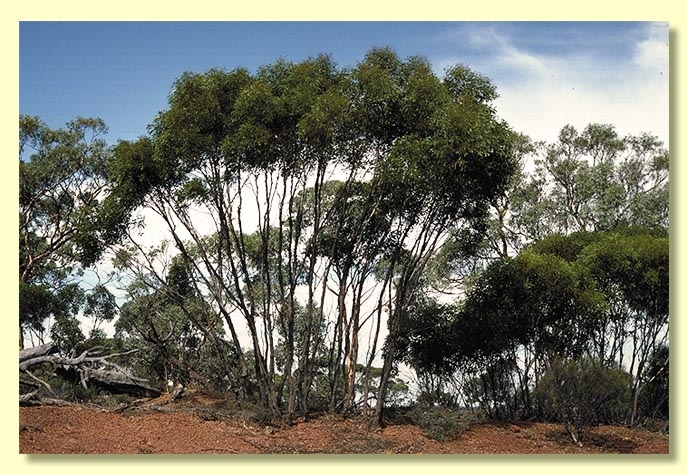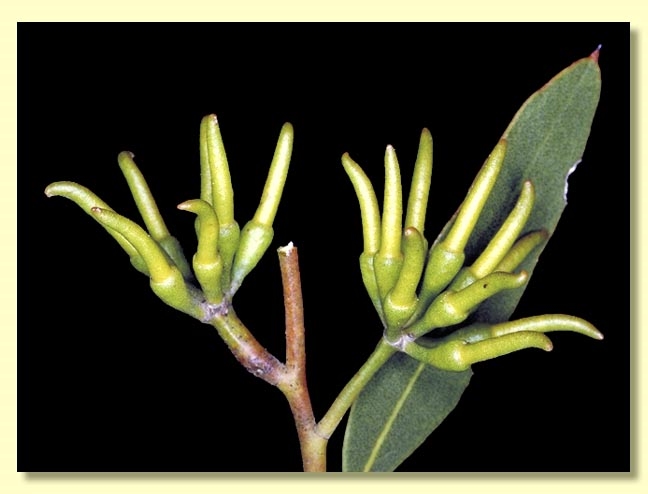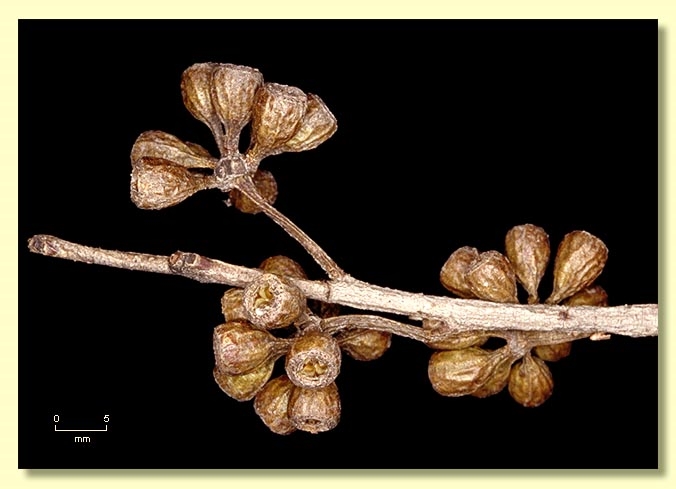Euclid - Online edition
Eucalyptus arachnaea subsp. arachnaea
Classification
Eucalyptus | Symphyomyrtus | Bisectae | Glandulosae | Levispermae | Phaenophylla
Nomenclature
Description
Mallee to 5 m tall. Forming a lignotuber.
Bark rough, grey-black for up to 2.5 m of trunk, tightly fibrous and fissured to flaky, smooth above, grey and yellowish brown.
Branchlets with pith oil glands at the nodes.
Juvenile growth (coppice or field seedlings to 50 cm): stems triangular in cross-section when young, soon rounded, warty; juvenile leaves always petiolate, opposite for ca 3 nodes then alternate, ovate, 5.5–9 cm long, 3–5.5 cm wide, base tapered or truncate to rounded, blue-green to slightly glaucous.
Adult leaves alternate, petioles 0.8–2 cm long; blade lanceolate, 6–12 cm long, 1–2.2 cm wide, base tapering to petiole, margin entire apex pointed, concolorous, very glossy, green, side-veins greater than 45° to midrib, reticulation moderate to dense, intramarginal vein remote from margin, oil glands mostly island.
Inflorescence axillary unbranched, peduncles widening apically, 0.8–1.8 cm long, buds 11 to 15 per umbel, pedicellate (pedicels 0.2–0.4 cm long). Mature buds elongated-fusiform (1.2–2 cm long, 0.2–0.4 cm wide), scar present, operculum horn-shaped three to four times the length of the hypanthium and narrowest above the join, a few outer stamens erect, most deflexed to varying extent, anthers oblong, versatile, dorsifixed, dehiscing by longitudinal slits, style long and straight, stigma more or less tapered, locules 3, the placentae each with 4 vertical rows of ovules. Flowers creamy white.
Fruit pedicellate (pedicels 0.2 cm long), cylindrical to cupular or obconical, 0.4–0.8 cm long, 0.4–0.5 cm wide, disc descending vertically, valves 3, near rim level or tips scarcely exserted.
Seeds straw-coloured, 0.8–1.2 mm, sub-spherical, surface smooth, hilum ventral/terminal.
Cultivated seedling (scored at ca node 10): cotyledons Y-shaped (bisected); stems more or less rounded in cross-section, slightly warty; leaves always petiolate, opposite for 3 or 4 nodes then alternate, ovate, 5–8 cm long, 2–5 cm wide, green, slightly glossy by node 10; earliest leaves with warts on leaf margin but smooth by node 5.
Bark rough, grey-black for up to 2.5 m of trunk, tightly fibrous and fissured to flaky, smooth above, grey and yellowish brown.
Branchlets with pith oil glands at the nodes.
Juvenile growth (coppice or field seedlings to 50 cm): stems triangular in cross-section when young, soon rounded, warty; juvenile leaves always petiolate, opposite for ca 3 nodes then alternate, ovate, 5.5–9 cm long, 3–5.5 cm wide, base tapered or truncate to rounded, blue-green to slightly glaucous.
Adult leaves alternate, petioles 0.8–2 cm long; blade lanceolate, 6–12 cm long, 1–2.2 cm wide, base tapering to petiole, margin entire apex pointed, concolorous, very glossy, green, side-veins greater than 45° to midrib, reticulation moderate to dense, intramarginal vein remote from margin, oil glands mostly island.
Inflorescence axillary unbranched, peduncles widening apically, 0.8–1.8 cm long, buds 11 to 15 per umbel, pedicellate (pedicels 0.2–0.4 cm long). Mature buds elongated-fusiform (1.2–2 cm long, 0.2–0.4 cm wide), scar present, operculum horn-shaped three to four times the length of the hypanthium and narrowest above the join, a few outer stamens erect, most deflexed to varying extent, anthers oblong, versatile, dorsifixed, dehiscing by longitudinal slits, style long and straight, stigma more or less tapered, locules 3, the placentae each with 4 vertical rows of ovules. Flowers creamy white.
Fruit pedicellate (pedicels 0.2 cm long), cylindrical to cupular or obconical, 0.4–0.8 cm long, 0.4–0.5 cm wide, disc descending vertically, valves 3, near rim level or tips scarcely exserted.
Seeds straw-coloured, 0.8–1.2 mm, sub-spherical, surface smooth, hilum ventral/terminal.
Cultivated seedling (scored at ca node 10): cotyledons Y-shaped (bisected); stems more or less rounded in cross-section, slightly warty; leaves always petiolate, opposite for 3 or 4 nodes then alternate, ovate, 5–8 cm long, 2–5 cm wide, green, slightly glossy by node 10; earliest leaves with warts on leaf margin but smooth by node 5.
Flowering Time
Flowering has been recorded in January and February.
Notes
Eucalyptus arachnaea is a species with mallee or mallet habit, endemic to Western Australia, widespread in subcoastal areas from north of Murchison River south-east to Wagin, usually on low hilly country. Bark rough on lower part of stems, dark grey to grey-black. Adult leaves are glossy green. Inflorescences are distinct in the many slender buds forming a spidery cluster.
E. arachnaea belongs to Eucalyptus subgenus Symphyomyrtus section Bisectae subsection Glandulosae because the cotyledons are bisected, buds have an operculum scar and the branchlets have oil glands in the pith. Within this subsection E. arachnaea is one of a group of seven species that form series Levispermae subseries Phaenophylla characterised by having smooth sub-spherical seed, a peduncle that widens apically, buds that are narrowly fusiform with some stamens erect and others variably deflexed, and glossy green leaves. The other six species in subseries Phaenophylla are E. clivicola, E. histophylla, E. luteola, E. flavida, E. phaenophylla and E. tumida.
The rough bark, very elongated buds (to 1.8 cm long) with operculum recurved at the tip and narrower than the hypanthium at the join, and the seedling leaves with warty margins distinguish E. arachnaea from other glossy-leaved species in series Levispermae.
There are two subspecies:
E. arachnaea subsp. arachnaea
The more widespread mallee form which occurs over the whole of the species' distribution apart from the most inland sites.
E. arachnaea subsp. arrecta
The mallet form that is only known from west of Morawa, south-east of Geraldton, in relatively high, stony, hilly country where it forms small pure stands emergent from the more dominant lower mallee scrub of the area. Uncommon.
E. arachnaea belongs to Eucalyptus subgenus Symphyomyrtus section Bisectae subsection Glandulosae because the cotyledons are bisected, buds have an operculum scar and the branchlets have oil glands in the pith. Within this subsection E. arachnaea is one of a group of seven species that form series Levispermae subseries Phaenophylla characterised by having smooth sub-spherical seed, a peduncle that widens apically, buds that are narrowly fusiform with some stamens erect and others variably deflexed, and glossy green leaves. The other six species in subseries Phaenophylla are E. clivicola, E. histophylla, E. luteola, E. flavida, E. phaenophylla and E. tumida.
The rough bark, very elongated buds (to 1.8 cm long) with operculum recurved at the tip and narrower than the hypanthium at the join, and the seedling leaves with warty margins distinguish E. arachnaea from other glossy-leaved species in series Levispermae.
There are two subspecies:
E. arachnaea subsp. arachnaea
The more widespread mallee form which occurs over the whole of the species' distribution apart from the most inland sites.
E. arachnaea subsp. arrecta
The mallet form that is only known from west of Morawa, south-east of Geraldton, in relatively high, stony, hilly country where it forms small pure stands emergent from the more dominant lower mallee scrub of the area. Uncommon.
Origin of Name
Copyright © CANBR 2020, all rights reserved.

Web edition hosted at https://apps.lucidcentral.org/euclid














